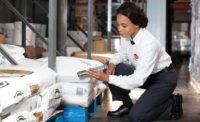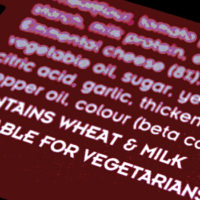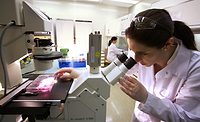Your brand is your company’s most valuable asset. That is why it’s vital to help protect your products from all sources of cross-contamination.
Floors and drains are often identified as a source for dangerous pathogens and spoilage organisms. Cracks and porous areas common to floors and drains are potential harborage sites for bacteria. Doorways can provide a gateway between rooms for transfer of bacteria. It is critical to limit employee and fork truck traffic to help prevent cross-contamination.
A comprehensive floor, drain and doorway sanitization program will help protect your products from environmental contamination. Regular nightly cleanup and continuous preventative steps during the production day will help control microbial growth and help minimize your food safety risk.
A comprehensive solution for your operation as part of your complete food safety program should consist of the following:
• Nightly: cleaning and sanitization of drains, floors and environmental surfaces.
• During the workday: maintain cleaned, sanitized floors and drains with EPA-registered, time-released, water-activated sanitizer products labeled with directions for use during production. Consistent usage of doorway sanitization systems to help prevent cross-contamination between plant areas.
Before using any cleaning and sanitizing products, read and understand all product labels and material safety data sheets and use proper personal protective equipment (PPE). Use tag-out as required by plant procedures and exercise caution when walking on wet floors. Follow the cleaning and sanitizing procedures outlined by your sanitation supplier.
Floor Care
Nightly floor cleaning can be accomplished by either foam cleaning or cleaning with an industrial scrubber. After foaming, floors should be rinsed and squeegeed dry. Once floors have been cleaned, spray the floor with an EPA-registered sanitizer—do not rinse.
To help improve environmental sanitization on floors during production, use an EPA-registered, water-activated, time-released sanitizer such as Ecolab’s Sani-Step™. This product provides longer activity than convention liquid sanitizers alone and helps prevent microorganism growth in wet conditions during processing. It is effective against the following pathogenic microorganisms when used according to label directions: Listeria monocytogenes, Salmonella enterica, Escherichia coli, Staphylococcus aureus and Enterobacter aerogenes.
Drain Care
Floor drains should be cleaned and sanitized daily after initial rinsing of heavy soils and prior to cleaning processing equipment. Follow drain cleaning and sanitizing procedures outlined by your sanitation supplier very carefully.
Boost™ 3000 and Boost™ 3001 comprise a two-part drain solution that effectively removes and controls biofilm and other organic contaminants commonly found in drains, pipes and hard-to-reach trunk lines without scrubbing. This EPA-registered, patented technology is specially formulated to penetrate and remove biofilms while acting as a bactericide, slimicide and algicide. The easy-to-use foam typically requires less than a minute to clean with no scrubbing required. It allows for disinfection past the trap and full 360º coverage of the drain line.
To help prevent microorganism growth in drains 24 hours a day, use an EPA-registered, time-released, circular sanitizing system such as Ecolab Pathways® Solid Drain Sanitizer. The water-activated formulation helps prevent microorganism growth in wet conditions and fits directly into drains, reducing build-up between daily cleanings.
For continuous, time-released protection in refrigeration or air conditioner drip pans and drains, use an EPA-registered microbicide such as Ecolab Drain Pan Treatment & Microbiocide™. This flexible solid block allows for form fitting in tough-to-reach drip pan locations and helps prevent microorganism growth in wet conditions.
www.ecolab.com
Help Control Cross- contamination with a Comprehensive Sanitization Program




